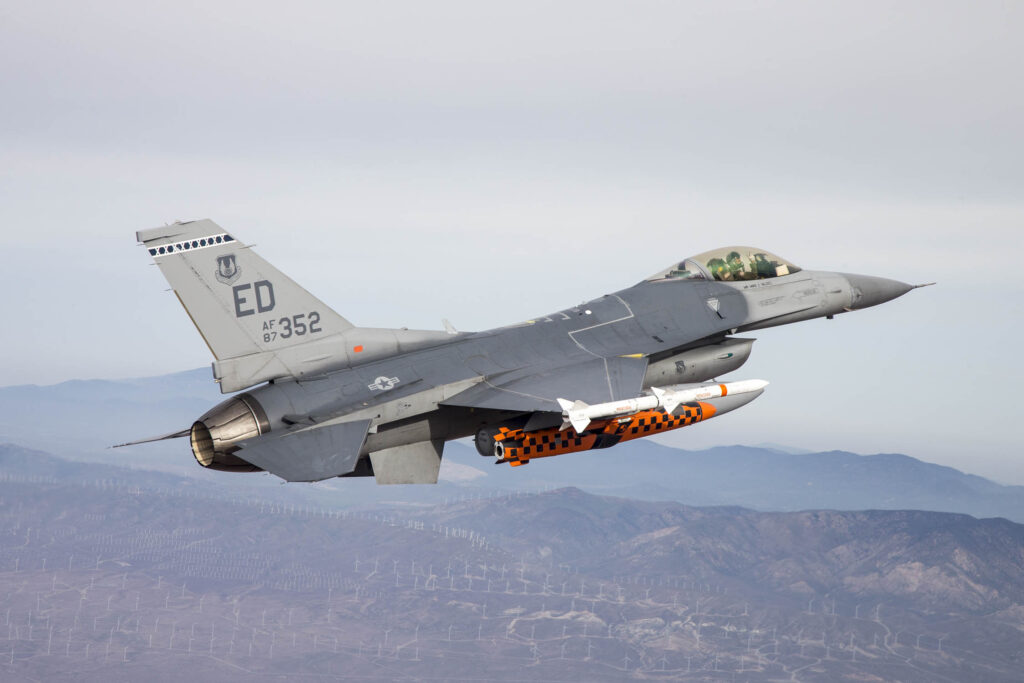
Raytheon-Kongsberg JSM carried on an F-16
WASHINGTON: Raytheon expects a new flight test of its Joint Strike Missile (JSM), being developed in partnership with Norwegian firm Kongsberg Defence & Aerospace, to happen later this year, says Kurt Neubauer, business development lead for Raytheon Air Warfare Systems.
In an email conversation, Neubauer said the flight test will build upon the successful 2018 JSM flight test of a live warhead with a second, live-warhead demonstration later this year. Kongsberg has also completed internal weapons bay suspension and fitting tests of the JSM on the F-35 A and C aircraft variants. In addition, fit checks have been completed on all F-35 variant external wing stations, as well as, the Navy’s F/A-18E/F.
Norway launched the JSM from an F-16 during a successful flight test in 2018, demonstrating a standoff range of more than 150 nautical miles. Norway and Japan are the first customers for the new missile. It can be launched against targets on land, at sea, and in littoral environments to conduct suppression/destruction of enemy air defenses along with offensive anti-surface warfare.
Raytheon describes the missile as “a fifth-generation weapon for fifth-generation aircraft.”
“We expect the Royal Norwegian Air Force to declare IOC with JSM on their F-35As in 2023,” Neubauer said. He noted that Japan also has selected JSM for the Japan Self Defense Force’s Joint Strike Fighters. “Raytheon and Kongsberg are marketing the missile to the USAF, USN, and other allies and partners”.
The missile has a potentially wide customer base, as it uses the venerable and ubiquitous Link-16 (TacNet) to provide two-way connection between the missile and launch or controlling aircraft.
Another one of JSM’s alluring features is its advanced imaging IR seeker, Neubauer explained. “JSM’s seeker is cooled, scans a wide field of view, uses multi-banded imaging infrared, and can track a large number of contacts simultaneously. It rejects decoys and can complete autonomous target identification for both ship and land targets,” he said.
While there are a number of strike weapons that incorporate navigation systems that reduce vulnerability to en-route threats, Neubauer said that “JSM has a robust mission planning system and precise navigation capability” that includes capability to utilize Global Positioning System satellites, an extremely precise inertial navigation system, and a digital terrain correlation.
“JSM is capable of tailoring en-route ingress and attack courses to enhance its survivability,” he elaborated. The TacNet link further “allows for inflight updates and route adjustments.” JSM’s survivability is enhanced through mission planning, both on the ground and when mated to the aircraft.
The missile is designed to operate in GPS denied areas.
According to a Raytheon fact sheet, JSM is an evolution of the Naval Strike Missile, which was originally developed for Norway’s Navy. NSM is a long-range, precision strike weapon that seeks and destroys enemy ships at distances greater than 100 nautical miles. That missile was recently deployed on the USS Gabrielle Giffords (LCS 10).
“In 2018, Raytheon was awarded a U.S. Navy contract to manufacture and deliver NSM for over-the-horizon defense of littoral combat ships and future frigates,” the fact sheet states.
The two companies also partner on the National Advanced Surface-to-Air Missile System, or NASAMS, which comprises the Sentinel radar, Kongsberg Fire Distribution Center and Raytheon’s AMRAAM missile. “NASAMS provides the air defender with a tailorable, state-of-the-art defense system that can maximize their ability to quickly identify, engage and destroy current and evolving enemy aircraft, unmanned aerial vehicle and emerging cruise missile threats,” the fact sheet says.
Click here to learn more about Raytheon’s Joint Strike Missile.























